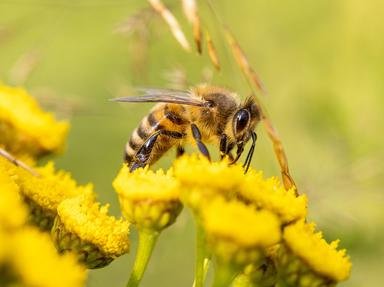Quiz Answer Key and Fun Facts
1. When my hives were set up, a new colony was placed in the box. What type of insect did I definitely NOT purchase?
2. Patience is required with a new hive. Only one box is used initially for a single swarm. What is the box called which contains the Queen and her new colony?
3. One of the groups within the hive has an easy life but a harsh death. Which bee is this, whose sole purpose is to mate with a young queen?
4. Every few weeks, I check my hives for health and development. Ouch! Ive been stung on an exposed wrist! How do I prevent more stings?
5. My colony is doing nicely, and I see that the frames in my brood box are almost full, with areas of brood (eggs, pupa and larva) surrounded by regions of capped honey. What can I do to encourage more honey?
6. I've been reading about the things that can go wrong with a beehive. Honeybees have a number of threats to their survival. Which of these is NOT a threat?
7. Colony collapse disorder was identified first in the USA, but is now thought to be the major threat to both native and domesticated bees worldwide. What can be done to reduce this threat, which has reduced American colonies by as much as 30 - 40% in recent years?
8. One type of honeybee will die after delivering its sting. Which of these is it?
9. Worker bees generally only live about 5 - 6 weeks after emerging from their cells, while drones generally live longer. What is the average lifespan of a queen?
10. Honey gathering must have started opportunistically, with hunter-gatherers robbing wild hives. According to recorded history, when did humans first cultivate bees?
Source: Author
windrush
This quiz was reviewed by FunTrivia editor
guitargoddess before going online.
Any errors found in FunTrivia content are routinely corrected through our feedback system.
